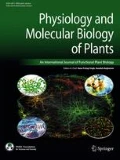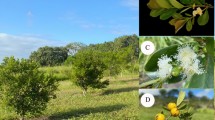Abstract
Safflower (Carthamus tinctorius L.) is considered as an oil crop that is rich in medicinal and industrial properties. In this study, the genetic diversity of safflower was assessed using 12 polymorphic sequence-related amplified polymorphism (SRAPs) and 11 polymorphic start codon targeted (SCoT) markers in 100 genotypes of safflower gathered from different geographical regions of the world. The 23 primers generated a total of 227 polymorphism fragments with a mean of 68.2% within the range of 3 (SCoT 31 and SCoT 35) to 13 (SCoT 35) bands per primer. Polymorphism per primer ranged between 100% (in Me4–Em1) and 18.1% (in SCoT19), with an average of 36.76%. The polymorphism information contents of the SRAP and SCoT markers were 0.35 and 0.30, respectively, indicating that SRAP markers were more effective than SCoT markers for assessing the degree of genetic diversity of the safflower. The results of the analysis of molecular variance showed a significant difference across cultivated safflower genotypes possessing a high intra-population variation. The examined accessions were categorized into five clusters based on similarity centers: the Middle East containing Iran, Iraq, Turkey, and Tajikistan; the Far East, including India, Pakistan, and Korea; Europe; the American continent; and Africa, including Egypt, Sudan and Libya. The present study shows the effectiveness of employing the mixture of SRAP and SCoT markers in the identification of safflower genetic diversity that would be useful for conservation and population genetics of safflower improvement in further studies.


Similar content being viewed by others
References
Al-Snafi AE (2015) The chemical constituents and pharmacological importance of Carthamus tinctorius—an overview. J Pharm Biol 5(3):143–166
Ambreen H, Kumar S, Variath MT, Joshi G, Bali S, Agarwal M, Kumar A, Jagannath A, Goel S (2015) Development of genomic microsatellite markers in Carthamus tinctorius L. (Safflower) using next generation sequencing and assessment of their cross-species transferability and utility for diversity analysis. PLoS ONE 10(8):e0135443
Amirmoradi B, Talebi R, Karami E (2012) Comparison of genetic variation and differentiation among annual Cicer species using start codon targeted (SCoT) polymorphism, DAMD-PCR, and ISSR markers. Plant Syst Evol 298:1679–1688
Anderson JA, Churchill GA, Autrique JE, Sorells ME, Tanksley SD (1993) Optimizing parental selection for genetic-linkage maps. Genome 36:181–186
Bahmankar M, Nabati DA, Dehdari M (2017) Genetic relationships among Iranian and exotic safflower using microsatellite markers. J Crop Sci Biotechnol 20(3):159–165
Barati M, Arzani A (2012) Genetic diversity revealed by EST-SSR markers in cultivated and wild safflower. Biochem Syst Ecol 44:117–123
Chapman MA, Hvala J, Strever J, Burke JM (2010) Population genetic analysis of safflower (Carthamus tinctorius; Asteraceae) reveals a Near Eastern origin and five centers of diversity. Am J Bot 97:831–840
Collard BC, Mackill DJ (2009) Start codon targeted (SCoT) polymorphism: a simple, novel DNA marker technique for generating gene-targeted markers in plants. Plant Mol Biol Rep 27:86
Deng L, Liang Q, He X, Luo C, Chen H, Qin Z (2015) Investigation and analysis of genetic diversity of diospyros germplasms using SCoT molecular markers in Guangxi. PLoS ONE 10:e0136510
Derakhshan E, Majidi MM, Sharafi Y, Mirlohi A (2014) Discrimination and genetic diversity of cultivated and wild safflowers (Carthamus spp.) using EST-microsatellites markers. Biochem Syst Ecol 54:130–136
Ellis J, Burke J (2007) EST-SSRs as a resource for population genetic analyses. Heredity 99:125–132
Etminan A, Pour-Aboughadareh A, Mohammadi R, Ahmadi-Rad A, Noori A, Mahdavian Z, Moradi Z (2016) Applicability of start codon targeted (SCoT) and inter-simple sequence repeat (ISSR) markers for genetic diversity analysis in durum wheat genotypes. Biotechnol Biotechnol Equip 30(6):1075–1081
Excoffier L, Smouse PE, Quattro JM (1992) Analysis of molecular variance inferred from metric distances among DNA haplotypes: application to human mitochondrial DNA restriction data. Genetics 131:479–491
Golkar P (2014) Breeding improvements in safflower (Carthamus tinctorius L.): a review. Aust J Crop Sci 8:1079–1085
Golkar P, Arzani A, Rezaei AM (2011) Genetic variation in safflower (Carthamus tinctorious L.) for seed quality-related traits and inter-simple sequence repeat (ISSR) markers. Int J Mol Sci 12:2664–2677
Hajibarat Z, Saidi A, Hajibarat Z, Talebi R (2015) Characterization of genetic diversity in chickpea using SSR markers, start codon targeted polymorphism (SCoT) and conserved DNA-derived polymorphism (CDDP). Physiol Mol Biol Plant 21:365–373
Hedrick PW (1999) Perspective: highly variable loci and their interpretation in evolution and conservation. Evolution 53:313–318
Huang LK, Jiang XY, Huang QT, Xiao YF, Chen ZH, Zhang XQ, Miao JM, Yan HD (2014) Genetic diversity and relationships in cultivars of Lolium multiflorum Lam. using sequence-related amplified polymorphism markers. Genet Mol Res 13(4):10142–10149
Jaccard P (1908) Nouvelles recherches sur la distribution florale. Bull Soc Vaud Sci Nat 44:223–270
Khalid N, Khan RS, Hussain MI, Farooq M, Ahmad A, Ahmed I (2017) A comprehensive characterization of safflower oil for its potential applications as a bioactive food ingredient—a review. Trends Food Sci Technol 66:176–186
Khan MA, von Witzke-Ehbrecht S, Maass BL, Becker HC (2009) Relationships among different geographical groups, agro-morphology, fatty acid composition and RAPD marker diversity in safflower (Carthamus tinctorius). Genet Resour Crop Evol 56:19–30
Kiran BU, Mukta N, Kadirvel P, Alivelu K, Senthilvel S, Kishore P, Varaprasad KS (2017) Genetic diversity of safflower (Carthamus tinctorius L.) germplasm as revealed by SSR markers. Plant Genet Resour 15(1):1–11
Knowles P (1969) Centers of plant diversity and conservation of crop germplasm: safflower. Econ Bot 23:324–329
Kumar Mishra M, Suresh N, Bhat AM, Suryaprakash N, Satheesh Kumar S, Kumar A (2011) Genetic molecular analysis of Coffea arabica (Rubiaceae) hybrids using SRAP markers. Rev Biol Trop 59(2):607–617
Kumar S, Ambreen H, Variath MT, Rao AR, Agarwal M, Kumar A, Goel S, Jagannath A (2016) Utilization of molecular, phenotypic and geographical diversity to develop compact composite core collection in the oilseed crop, Safflower (Carthamus tinctorius L.) through maximization strategy. Front. Plant Sci 7:1554
Li G, Quiros CF (2001) Sequence-related amplified polymorphism (SRAP), a new marker system based on a simple PCR reaction: its application to mapping and gene tagging in Brassica. Theor Appl Genet 103:455–461
Mayerhofer M, Mayerhofer R, Topinka D, Christianson J, Good AG (2011) Introgression potential between safflower (Carthamus tinctorius) and wild relatives of the genus Carthamus. BMC Plant Biol 11:47
Mokhtari N, Rahimmalek M, Talebi M, Khorrami M (2013) Assessment of genetic diversity among and within Carthamus species using sequence-related amplified polymorphism (SRAP) markers. Plant Syst Evol 299:1285–1294
Mulpuri S, Muddanuru T, Francis G (2013) Start codon targeted (SCoT) polymorphism in toxic and non-toxic accessions of Jatropha curcas L. and development of a codominant SCAR marker. Plant Sci 207:117–127
Murray MG, Thompson WF (1980) Rapid isolation of high molecular weight plant DNA. Nucleic Acids Res 8:4321–4326
Nei M (1983) Genetic polymorphism and the role of mutation in evolution. Evol Genes Proteins 71:165–190
Peng S, Feng N, Guo M, Chen Y, Guo Q (2008) Genetic variation of Carthamus tinctorius L. and related species revealed by SRAP analysis. Biochem Syst Ecol 36:531–538
Poczai P, Varga I, Laos M, Cseh A, Bell N, Valkonen JPT, Hyvönen J (2013) Advances in plant gene-targeted and functional markers: a review. Plant Methods 9:6
Reeves PA, Panella LW, Richards CM (2012) Retention of agronomically important variation in germplasm core collections: implications for allele mining. Theor Appl Genet 124:1155–1171
Robarts DW, Wolfe AD (2014) Sequence-related amplified polymorphism (SRAP) markers: a potential resource for studies in plant molecular biology. Appl Plant Sci 2:1400017
Rohlf FJ (1992) NTSYS-PC: numerical taxonomy and multivariate analysis system version 2.0. State University of New York, Stony Brook
Satya P, Karan M, Jana S, Mitra S, Sharma A, Karmakar P, Ray D (2015) Start codon targeted (SCoT) polymorphism reveals genetic diversity in wild and domesticated populations of ramie (Boehmeria nivea L. Gaudich.), a premium textile fiber producing species. Meta Gene 3:62–70
Sehgal D, Raina SN (2005) Genotyping safflower (Carthamus tinctorius) cultivars by DNA fingerprints. Euphytica 146:67–76
Shannon CE (1948) A mathematical theory of communication. Bell Syst Tech J 27:379–423, 623–656
Uzun A, Yesiloglu T, Aka-Kacar Y, Tuzcu O, Gulsen O (2009) Genetic diversity and relationships within Citrus and related genera based on sequence related amplified polymorphism markers (SRAPs). Sci Hortic 121:306–312
Vilatersana R, Garnatje T, Susanna A, Garcia-Jacas N (2005) Taxonomic problems in Carthamus (Asteraceae): RAPD markers and sectional classification. Bot J Linn Soc 147:375–383
Wang Z, Wang JE, Wang XM, Gao HW, Dzyubenko NI, Chapurin VF (2012) Assessment of genetic diversity in Galega officinalis L. using ISSR and SRAP markers. Genet Resour Crop Evol 59(5):865–873
Wright S (1984) Evolution and the genetics of populations: experimental results and evolutionary deductions, vol 3. University of Chicago Press, Chicago
Xie W, Zhang X, Cai H, Huang L, Peng Y, Ma X (2010) Genetic maps of SSR and SRAP markers in diploid orchardgrass (Dactylis glomerata L.) using the pseudo-testcross strategy. Genome 54:212–221
Xiong F, Zhong R, Han Z, Jiang J, He L, Zhuang W, Tang R (2011) Start codon targeted polymorphism for evaluation of functional genetic variation and relationships in cultivated peanut (Arachishy pogaea L.) genotypes. Mol Biol Rep 38:3487–3494
Yaman H, Tarıkahya-Hacıoglu B, Arslan Y, Subasi I (2014) Molecular characterization of the wild relatives of safflower (Carthamus tinctorius L.) in Turkey as revealed by ISSRs. Genet Resour Crop Evol 61:595–602
Yang YX, Wu W, Zheng YL, Chen L, Liu RJ, Huang CY (2007) Genetic diversity and relationships among safflower (Carthamus tinctorius L.) analyzed by inter-simple sequence repeats (ISSRs). Genet Resour Crop Evol 54(5):1043–1051
Yeh F, Yang R, Boyle T (1999) POPGENE. Microsoft Window based freeware for population genetic analysis. Version 1.32. Centre for International Forestry Research, University of Alberta, Edmonton
Zhang L, Huang B-B, Kai G-Y, Guo M-L (2006) Analysis of intraspecific variation of Chinese Carthamus tinctorius L. using AFLP markers. Acta Pharm Sin 41(1):91–96
Acknowledgements
The authors would like to thank Research Institute for Biotechnology and Bioengineering, Isfahan University of Technology, Isfahan, Iran. We appreciated Radan English Edit Company for editing the paper.
Author information
Authors and Affiliations
Corresponding author
Electronic supplementary material
Below is the link to the electronic supplementary material.
Rights and permissions
About this article
Cite this article
Golkar, P., Mokhtari, N. Molecular diversity assessment of a world collection of safflower genotypes by SRAP and SCoT molecular markers. Physiol Mol Biol Plants 24, 1261–1271 (2018). https://doi.org/10.1007/s12298-018-0545-0
Received:
Revised:
Accepted:
Published:
Issue Date:
DOI: https://doi.org/10.1007/s12298-018-0545-0




